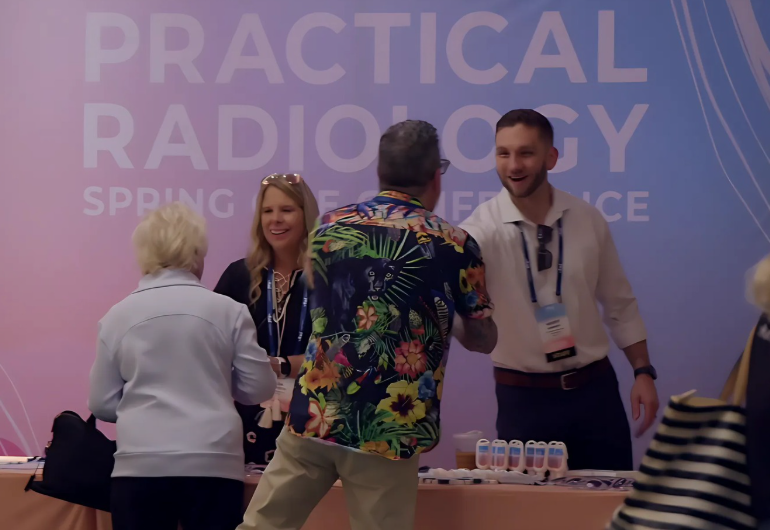"This was the best radiology conference
I’ve ever attended in my career. Great content, great people."
- 2024 Conference Attendee

Remote radiologist jobs with flexible schedules, equitable pay, and the most advanced reading platform. Discover teleradiology at vRad.

Radiologist well-being matters. Explore how vRad takes action to prevent burnout with expert-led, confidential support through our partnership with VITAL WorkLife. Helping radiologists thrive.

Visit the vRad Blog for radiologist experiences at vRad, career resources, and more.

vRad provides radiology residents and fellows free radiology education resources for ABR boards, noon lectures, and CME.

Teleradiology services leader since 2001. See how vRad AI is helping deliver faster, higher-quality care for 50,000+ critical patients each year.

Subspecialist care for the women in your community. 48-hour screenings. 1-hour diagnostics. Comprehensive compliance and inspection support.

vRad’s stroke protocol auto-assigns stroke cases to the top of all available radiologists’ worklists, with requirements to be read next.

vRad’s unique teleradiology workflow for trauma studies delivers consistently fast turnaround times—even during periods of high volume.

vRad’s Operations Center is the central hub that ensures imaging studies and communications are handled efficiently and swiftly.

vRad is delivering faster radiology turnaround times for 40,000+ critical patients annually, using four unique strategies, including AI.
.jpg?width=1024&height=576&name=vRad-High-Quality-Patient-Care-1024x576%20(1).jpg)
vRad is developing and using AI to improve radiology quality assurance and reduce medical malpractice risk.

Now you can power your practice with the same fully integrated technology and support ecosystem we use. The vRad Platform.

Since developing and launching our first model in 2015, vRad has been at the forefront of AI in radiology.

Since 2010, vRad Radiology Education has provided high-quality radiology CME. Open to all radiologists, these 15-minute online modules are a convenient way to stay up to date on practical radiology topics.

Join vRad’s annual spring CME conference featuring top speakers and practical radiology topics.

vRad provides radiology residents and fellows free radiology education resources for ABR boards, noon lectures, and CME.

Academically oriented radiologists love practicing at vRad too. Check out the research published by vRad radiologists and team members.

Learn how vRad revolutionized radiology and has been at the forefront of innovation since 2001.

%20(2).jpg?width=1008&height=755&name=Copy%20of%20Mega%20Nav%20Images%202025%20(1008%20x%20755%20px)%20(2).jpg)

Visit the vRad blog for radiologist experiences at vRad, career resources, and more.


Explore our practice’s reading platform, breast imaging program, AI, and more. Plus, hear from vRad radiologists about what it’s like to practice at vRad.

Ready to be part of something meaningful? Explore team member careers at vRad.
In-Person Holiday Pricing: $750.00 (Ends Jan. 8)
In-Person Standard Rate: $880.00 (After Jan. 8)
Live Stream: $500.00
Residents - FREE
If you a veteran or current military service member or a resident please email education@vrad.com for your discount code.

"This was the best radiology conference
I’ve ever attended in my career. Great content, great people."
- 2024 Conference Attendee
Dr. Strong is vRad’s Chief Medical Officer and a nationally recognized educator who speaks widely on emergency and teleradiology practice. He presents regularly at RSNA, contributes to podcasts such as AJR, and lectures to more than 50 radiology residency programs each year. He is board certified in both radiology and emergency medicine.
Dr. Riascos is a Professor of Radiology and Neurosurgery at McGovern Medical School, serving as Section Chief of Neuroradiology and Vice Chair of Innovation. He directs the Center of Advanced Imaging Processing at Memorial Hermann Hospital–Texas Medical Center. He completed his neuroradiology fellowship at Louisiana State University Health Sciences Center and earned his medical degree from Escuela Colombiana de Medicina. Prior to McGovern, he served on faculty at UTMB in Galveston.
Dr. Avery is an Emergency Radiologist at Massachusetts General Hospital, where she completed both her residency and fellowship. She earned her medical degree from Wayne State University. With nearly two decades of experience in emergency imaging, she has held key educational roles, including serving as Radiology Clerkship Director for Harvard Medical School. She has received multiple teaching awards and holds the Robert Novelline Endowed Chair of Radiology at MGH.
Dr. Adler is an abdominal and ultrasound radiologist at Mayo Clinic Arizona. He completed his diagnostic radiology residency at Mayo Clinic Arizona and his abdominal imaging and intervention fellowship at the University of Wisconsin. He serves as Program Director for the Abdominal Imaging Fellowship, with interests in transplant and bowel imaging.
Dr. Lozano is a vRad Education Director, Wellness Advocate, and member of the First Read Initiative Executive Committee. She has led state and county medical and radiological societies, chaired AMA and ACR sections, and presented at major national meetings. She also advocates for person-first rather than disease-first language. In her free time, she studies DECT to help make the technology easier for radiologists, even if they share her earnest avoidance of physics.
"Really outstanding lectures. It is challenging to strike the right balance between providing a satisfying learning experience with in-depth expertise on a subject, while also tying it into daily clinical practice. But these speakers nailed it."
- 2024 Conference Attendee
CME at the Beach = Afternoons Free!
2026 Agenda Coming Soon
For our 2026 Practical Radiology conference, plan on a schedule with afternoons free! Leaving you plenty of time to enjoy all that beautiful Clearwater Beach has to offer.
Here are the hours you can expect:
8:00 AM – 8:45 AM
8:45 AM – 9:00 AM
9:00 AM – 9:30 AM
.png)
Cameron Adler, MD
Program Director, Mayo Clinic Arizona
9:30 AM – 10:00 AM

Benjamin Strong, MD
CMO, vRad
10:00 AM – 10:30 AM
.png)
Cameron Adler, MD
Program Director, Mayo Clinic Arizona
10:30 AM – 10:45 AM
10:45 AM – 11:15 AM
.png)
Cameron Adler, MD
Program Director, Mayo Clinic Arizona
11:15 AM – 11:45 AM
11:45 AM - 12:15 PM
.png)
Katie Lozano, MD, FACR
vRad Education Director
12:15 PM - 1:15 PM
1:15 PM - 1:45 PM
.png)
Katie Lozano, MD, FACR
vRad Education Director
1:45 PM - 2:45 PM
8:00 AM - 8:45 AM
8:30 AM - 9:00 AM
.png)
Roy F. Riascos, MD, FACR
Section Chief, McGovern Medical School
9:00 AM - 9:30 AM
.png)
Kathleen R. Fink, MD
Clinical Professor of Neurology, University of Wisconsin SoM
9:30 AM - 10:00 AM
.png)
Roy F. Riascos, MD, FACR
Section Chief, McGovern Medical School
10:00 AM – 10:15 AM
10:15 AM - 10:45 AM
.png)
Kathleen R. Fink, MD
Clinical Professor of Neurology, University of Wisconsin SoM
10:45 AM - 11:15 AM
.png)
Roy F. Riascos, MD, FACR
Section Chief, McGovern Medical School
11:15 AM - 11:45 AM
.png)
Laura Avery, MD
Emergency Radiologist, Massachusetts General Hospital
11:45 AM - 1:00 PM
1:00 PM - 1:30 PM
.png)
Roy F. Riascos, MD, FACR
Section Chief, McGovern Medical School
1:30 PM - 2:00 PM
.png)
Kathleen R. Fink, MD
Clinical Professor of Neurology, University of Wisconsin SoM
2:00 PM - 2:30 PM
.png)
Laura Avery, MD
Emergency Radiologist, Massachusetts General Hospital
8:00 AM - 8:45 AM
8:30 AM - 9:00 AM

Nicholas Beckmann, MD
Professor of Radiology; Chief, MSK, UTHealth Houston
9:00 AM - 9:30 AM

Nicholas Beckmann, MD
Professor of Radiology; Chief, MSK, UTHealth Houston
9:30 AM - 10:00 AM
.png)
Laura Avery, MD
Emergency Radiologist, Massachusetts General Hospital
10:00 AM – 10:15 AM
10:15 AM - 10:45 AM
.png)
Kathleen R. Fink, MD
Clinical Professor of Neurology, University of Wisconsin SoM
10:45 AM - 11:15 AM

Benjamin W. Strong, MD
CMO. vRad
11:15 AM - 11:45 AM

Nicholas Beckmann, MD
Professor of Radiology; Chief, MSK, UTHealth Houston
11:45 AM - 12:45 PM
12:45 PM - 1:15 PM

Nicholas Beckmann, MD
Professor of Radiology; Chief, MSK, UTHealth Houston
1:15 PM - 1:45 PM
.png)
Laura Avery, MD
Emergency Radiologist, Massachusetts General Hospital
1:45 PM - 2:15 PM

Benjamin W. Strong, MD
CMO, vRad
2:15 PM - 2:30 PM

Practical Radiology 2026 at the stunning
Don't miss this incredible new Clearwater Beach retreat, with Gulf views from every hotel room! Plus, with afternoons free, you'll get to enjoy everything this resort and Clearwater Beach have to offer.
Rated #14 Top Resort in Florida by Travel + Leisure’s World’s Best Awards, 2025. Visit hotel website for more information →
Book by February 17, 2026, to lock in the Practical Radiology group rate—rooms start at $399 + tax (regularly $600+).
Address: 430 S Gulfview Blvd, Clearwater Beach, FL 33767
Learn about our commitment to safety, the community, our policies, and more. Following CDC guidance and requirements set forth by the State of Nevada, masks are required for all guests and employees in all inside public spaces, regardless of vaccination status.
For sponsorship opportunities in 2026, please visit our sponsor page >>
Contact us at education@vrad.com.
.png?width=465&height=87&name=CME%20logo%20(1).png)
The Minnesota Medical Association designates this hybrid activity for a maximum of 15.00 AMA PRA Category 1 Credit(s)™. Physicians should claim only the credit commensurate with the extent of their participation in the activity.